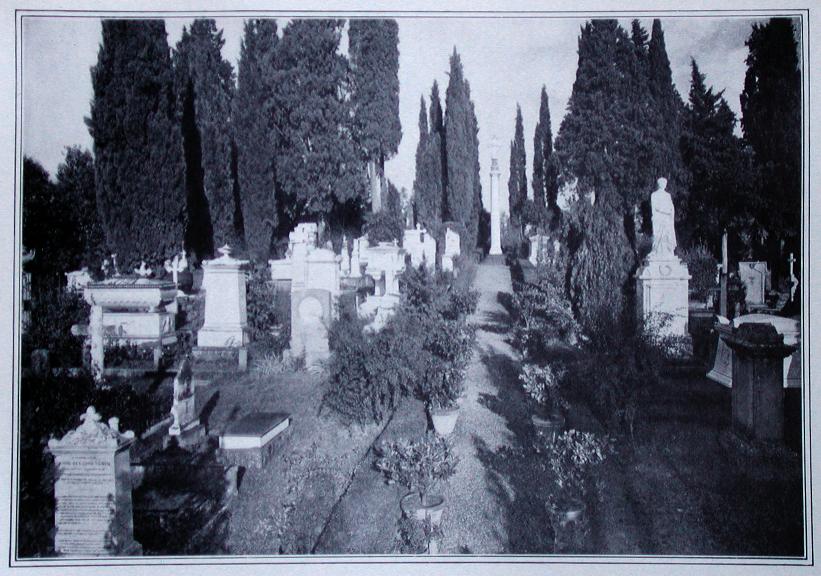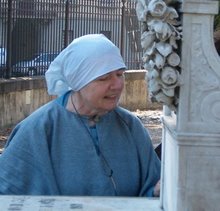
Today, 4 May 2007, Dr Vieri Torrigiani Malaspina has had his gardeners plant a climbing rose on Mrs Stisted's tomb, the one shaped like a four poster bed in wrought iron (I am longing to see what it does),

a white rose on the tomb of Anna Susanna Lloyd Horner (which originally had such a white rose from the Giardino Torrigiani),

and pomegranates by the tombs of Elizabeth Barrett Browning,

Walter Savage Landor

and Arthur Hugh Clough.

The tombs of Elizabeth Barrett Browning and Arthur Hugh Clough have already been restored. Tomorrow, Alberto Casciani of Meridiana Restauri comes to restore that of Walter Savage Landor and that of Mary Somerville's husband William Somerville, as well as to make moulds of Lord Leightons roundels of harps, Hebrew, Greek, Christian, the Hebrew harp with a broken slave shackle, on Elizabeth Barrett Browning's tomb for the Leighton House Museum http://www.rbkc.gov.uk/LeightonHouseMuseum/general/ in London. We chose the Somerville tomb to honour Mary Somerville, who discovered two planets and who taught Ada Lovelace, Lord Byron's daughter, mathematics, Ada, then, with Charles Babbage, inventing the computer.
Torrigiani's gardeners have also planted gardenias and hydrangeas in the terra cotta pots we have bought to go along the paths as in the ancient Brogi photograph of the Cemetery. We have proclaimed war on our fragrant laurel as the roots were damaging the tombs, the leaves their marble. These will be replaced with pomegranates, with myrtle, and with box.

Today, 4 May 2007, I discovered that the still fecund red rose by Elizabeth's tomb was planted by 'Professor Knight of Edinburgh'. I looked him up on the web. He came here in 1905, when he had retired from teaching moral philosophy, and his profound interest in women's education. A History of the English Church in Florence tells us:
"Many are the pilgrimages made to her grave, as the custode of the cemetery can tell, and only a few months ago Professor Knight of Edinburgh caused a rose tree to be planted there, and an enamelled plaque to be suspended to the iron railing which surrounds the grave, inscribed with these words: IN MEMORY OF/ ELIZABETH BARRETT BROWNING/ PLANTED BY PROFESSOR KNIGHT/ MARCH 1905/ ROSES SHALL BLOOM, NOR WANT BEHOLDERS,/ SPRUNG FROM THE DUST WHERE OUR OWN FLESH MOULDERS".

We have also planted eighteen lavender bushes along the brow of the hill, to form a hedge against its precipice. These given to us by the wife of a Scotsman whose ashes were buried there to the keening of his son in kilt and sporan on bagpipes. While delicate wildflowers, especially scarlet poppies, are everywhere, including by the tomb for an adolescent whose father had placed on it a sculpture of the Grim Reaper scything through poppies and lilies.


Here seen between the tombs of Fanny and Theodosia Trollope

Here the detail of the scythe swathing through poppies and lilies.
In August we will graft roses and myrtles and separate the wild irises, as well as the oleander, having one myrtle and one oleander left of the original nineteenth-century stock before everything was rooted out or put to weed-killer. Cherry trees, like laurel bushes we must banish, as their roots destroy tombs. But we should so love the small dogwood bushes, such as grow in Quincy, Illinois, with their delicate blooms. Also bulbs of different kinds of lilies, to go by the tombs on which they are sculpted. And more roses.
Dottor Vieri Torrigiani's website is at
http://www.giardinotorrigiani.it/. With Italian websites remember to click on the central image to enter. You will find a lovely account, but all in Italian, of their ancestral garden and its tower as a lung for the city of Florence, and of sending his gardeners out and about the city on bicycles!
This evening our blackbirds are still singing! Sometimes, too, we hear an owl, and also cuckoos. As well as the church bells of a convent near-by. All allowing us to forget that we live on an island in the midst of Florence's arterial traffic. Now we, too, can become a lung for the city of Florence providing her not with carbon dioxide and other noxious fumes but with oxygen, and sweet-smelling lavender and roses.
We are now at 1353 signatures on the web at http://www.thepetitionsite.com/takeaction/471134975,
'That the Swiss-owned, so-called 'English' Cemetery in Florence be kept open, be restored and be declared a UNESCO World Heritage Site', and with 3312 signatures in-house from our visitors, for a total of 4665 signatures. We have decided to keep them coming.
If you wish to donate to the Aureo Anello Association for the restoration of the 'English' Cemetery you can do so by a cheque made out to 'Aureo Anello' and posted to 'English' Cemetery, Piazzale Donatello 38, 50132 Florence, Italy; or through the Pay Pal 'Donate' button below, which can also be used for the CDs, for the hand-bound limited edition books or for the sculptures of Elizabeth and Robert's 'Clasped Hands' or tondos with their portraits (Amalia Ciardi Duprè's sculpture can also be found at http://www.florin.ms/amaliadupre.html), or some or all of these.

Sincerely,
Julia Bolton Holloway
Aureo Anello Association for the Library and Cemetery
Piazzale Donatello, 38
50132 FIRENZE, ITALY




